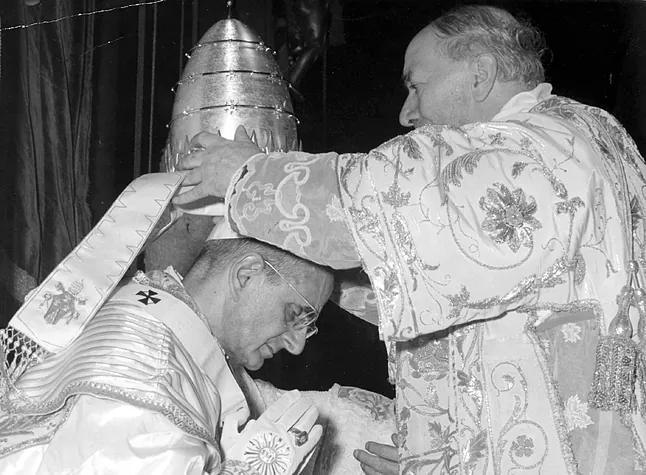Dozens of leaders from around the world will gather again this Sunday in St. Peter's Square at the Vatican to witness the pontificate inauguration mass of Leo XIV. A multitude of citizens will undoubtedly fill the place. The ceremony, meticulously planned with ancient rituals, hypnotic symbols of the Church, and beautiful Catholic liturgy, will be watched by viewers worldwide, captivated by the splendor that these events always radiate.
However, as grandiose as the event may seem, where the new Pontiff will receive the pallium and the fisherman's ring as symbols of his religious but also political responsibility, it will have little resemblance to the pomp with which the Catholic Church leaders' mandates began until the mid-20th century.
After the Second Vatican Council, it was considered inappropriate for new Popes to emulate the sovereign princes of the world, despite being so -let's not forget that they are also the head of state of the Vatican, the most unique monarchy on the globe. And with that spirit, Pope John Paul II, the beloved Traveling Pope, abolished the term "coronation" in the Apostolic Constitution Universi Dominici Gregis in 1996, referring to what has since been known simply as the pontificate inauguration ceremony.
With his motu proprio, the Holy Father was only terminologically accommodating what had already been established by facts. The last papal coronation took place in the splendid and luxurious enthronement of Pope Paul VI in June 1963. His successor, Pope John Paul I, the Brief Pope who barely held the position for 33 days until his death, dispensed in 1978 with being crowned with the triregnum tiara that had crowned all of Peter's successors since the Middle Ages.
The images of the coronation of Paul VI are as captivating as they are excessive by today's sensitivity towards Church matters, closely resembling the enthronement ceremonies of monarchs like the British, for example.
Giovanni Battista Enrico Antonio Maria Montini was carried to the altar in St. Peter's Basilica square -for the first time, the ceremony was held outdoors- on the gestatorial chair covered in cream-colored silk, carried by eight men. Accompanied by cheers from thousands of faithful along the way, he was escorted by Swiss Guard soldiers in full dress uniforms with swords raised, a dozen ushers, and high-ranking officials of the Pontifical Household.
During the ceremony, which had representatives from up to 80 nations, including several kings -highlighted by the Queen of the Belgians proudly wearing her white veil using the privilege du blanc reserved by the Church for Catholic queens- Paul VI was crowned with the papal tiara, while the cardinal deacon who placed it recited the old ritual: "Receive the tiara adorned with three crowns, and know that you are the Father of princes and kings, the ruler of the world, and the representative of Our Redeemer, to whom be honor and glory forever and ever. Amen."
It was indeed a rich triple crown, symbolizing sovereignty over the Pontifical State with the first crown, spiritual power over the secular with the second, and papal authority over the rest of the secular princes with the third. The first, it is worth noting, was an extraordinary achievement of the Church, hard-fought and pursued, which, after the unification of the Kingdom of Italy, was only realized in 1929 through the Lateran Treaties guaranteeing the independence of the Vatican City State.
The journey to the triple crown took centuries. It is documented that the early bishops of Rome, in an era of persecution by the Empire, were acclaimed with a simple Phrygian-inspired headpiece, whose form would be maintained over time. Apparently, Pope Sylvester was the first, in 314, to be crowned, with a simple tiara.
It was not until the late 13th century that a second crown was introduced, placed over the mitre -made of some precious metal- to symbolize the superiority of ecclesiastical power over the temporal, elevating the Pope as primus inter pares, even though powerful monarchs like the King of France were not pleased with this. And a few decades later, with Pope John XXII or Urban V, the third crown was added. The ensemble, topped with a small cross on a sphere or semisphere, would, as mentioned, last until 1963.
In the Modern Age, during the most tumultuous period in the history of the Papacy, amid excesses, lust, intrigues, power struggles among dynasties close to the Seat of St. Peter, and the lavish spending of patron Popes that have made the Vatican one of the most extraordinary museums in the world today, the papal crowns became especially luxurious. Unlike most monarchies, where successive monarchs usually wore the same historical pieces of their ancestors to emphasize dynastic continuity and legitimacy, Roman goldsmiths crafted a new tiara for each new Pope. These tiaras were adorned with all kinds of precious stones, many donated by European sovereigns seeking to gain the favor of Peter's successor.
Despite the 267 Popes in the history of the Church, unfortunately, only a few papal tiaras have been preserved. There are several reasons for this. Among them, Clement VII ordered during the Sack of Rome, ordered by our Charles I and V of Germany in 1527, to melt the Vatican jewels to meet the ransom demanded by the emperor.
Another curious historical fact is that Popes like Pius VII, due to the turmoil of the time, had to be crowned -in his case in 1800- with mitres made of papier-mâché, barely covered with silver fabric. However, Pius VII would later receive a magnificent crown from Napoleon, made by none other than the jeweler Chaumet -a big deal-, using some of the valuable pieces looted by the French in Rome.
This Sunday, everything will be more restrained in the mass where the faithful and the international community will welcome the successor of Francis. Although the Vatican is well aware in 2025 that a certain ceremonial magnificence is essential to radiate the essence of the mystery inherent to the papal institution.
